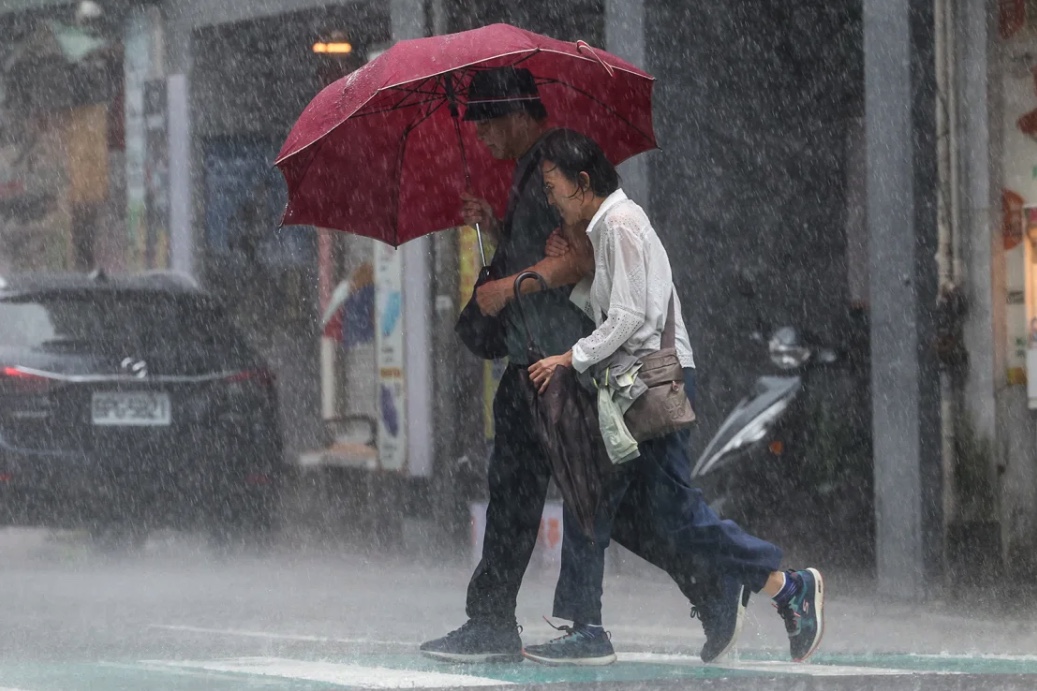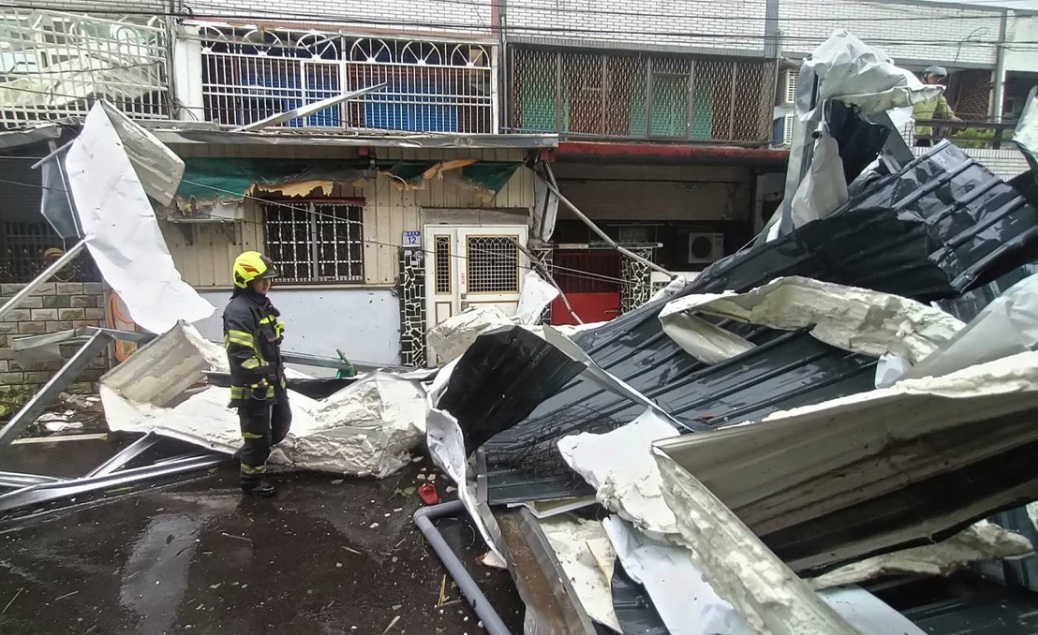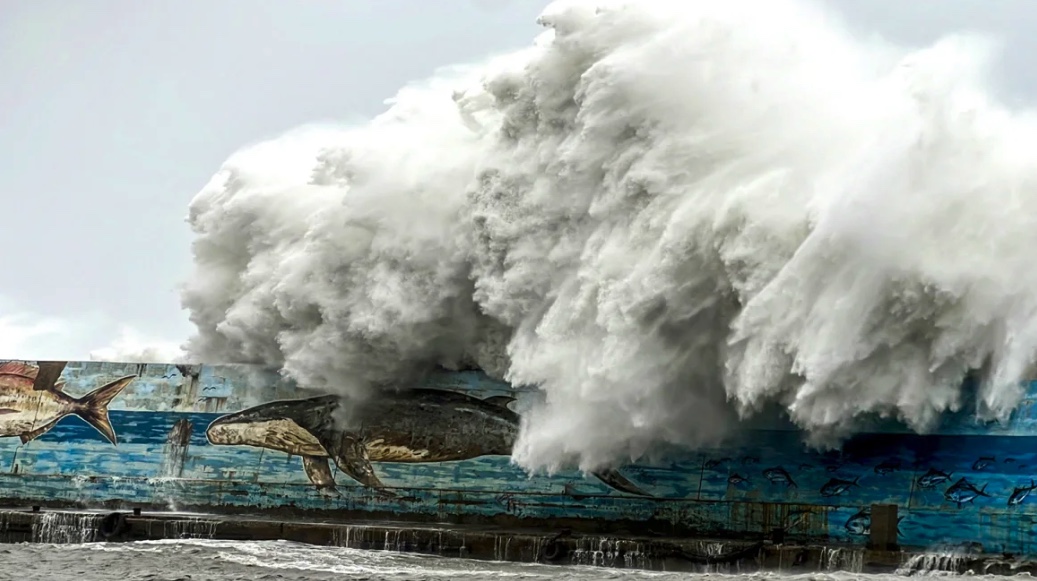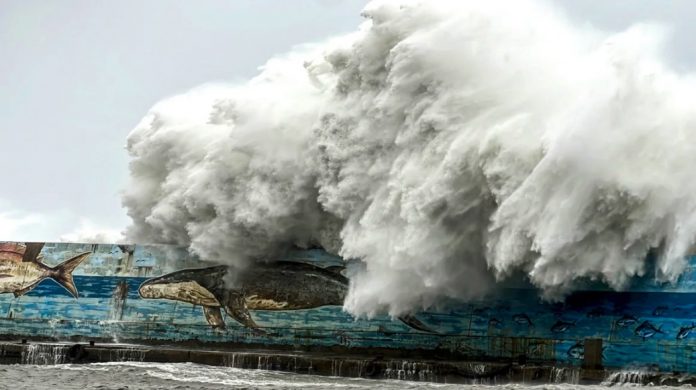พายุไต้ฝุ่นกองเร็ยนำพาฝนตกหนักและลมกระโชกแรงเข้าถล่มไต้หวันในวันพฤหัสบดี นับเป็นพายุลูกใหญ่ที่สุดที่พัดกระหน่ำเกาะแห่งนี้ในรอบเกือบสามทศวรรษ ทำให้มีผู้เสียชีวิตอย่างน้อย 1 รายและบาดเจ็บอีกหลายสิบคน
พายุไต้ฝุ่นกองเร็ยที่พัดถล่มในช่วงบ่ายวันพฤหัสบดีที่เมืองไถตง มีความเร็วลมใกล้จุดศูนย์กลางสูงสุดที่ประมาณ 200 กิโลเมตรต่อชั่วโมง (125 ไมล์ต่อชั่วโมง) ซึ่งเทียบเท่ากับพายุเฮอริเคนระดับ 3 ตามข้อมูลจากศูนย์เตือนภัยไต้ฝุ่นร่วม (JTWC)
รัศมีของลมที่แรงที่สุดของกองเร็ยซึ่งวัดได้ประมาณ 320 กิโลเมตร (เกือบ 200 ไมล์) เมื่อเย็นวันพุธ ทำให้มันเป็นพายุที่ใหญ่ที่สุดที่พัดถล่มไต้หวันนับตั้งแต่พายุไต้ฝุ่นเฮิร์บในปี 1996 ตามข้อมูลของ จาง ชุนเหยา นักพยากรณ์จากสำนักอุตุนิยมวิทยากลางไต้หวัน
ศูนย์ปฏิบัติการฉุกเฉินกลางของไต้หวัน (CEOC) รายงานว่า หญิงวัย 56 ปีเสียชีวิตจากต้นไม้ล้มทับขณะเดินทางโดยรถยนต์ในเมืองหนานโถว ขณะที่ยอดผู้บาดเจ็บทั่วเกาะมีอย่างน้อย 73 ราย

ก่อนพายุเข้า รัฐบาลท้องถิ่นได้สั่งให้ปิดสถานที่ราชการและโรงเรียนชั่วคราว และหยุดการซื้อขายในตลาดหลักทรัพย์
แม้ไต้หวันจะมีความเชี่ยวชาญในการรับมือกับไต้ฝุ่นขนาดใหญ่ แต่ชุมชนในพื้นที่ห่างไกลโดยเฉพาะในภูมิภาคที่เป็นภูเขา ยังคงมีความเสี่ยงต่อการเกิดดินถล่มสูง
กองทัพไต้หวันได้จัดกำลังพลกว่า 34,000 นายเพื่อเตรียมพร้อมให้การช่วยเหลือ ขณะที่มีการอพยพประชาชนมากกว่า 8,600 คนออกจากพื้นที่เสี่ยงสูงตั้งแต่วันพุธที่ผ่านมา

เที่ยวบินกว่า 500 เที่ยว รวมถึงเที่ยวบินระหว่างประเทศกว่า 300 เที่ยวถูกยกเลิก และบริการเรือข้ามฟากไปยังเกาะรอบนอกทั้งหมดถูกระงับ ตามรายงานจากสำนักงานการบินพลเรือนไต้หวัน ขณะที่บริการรถไฟความเร็วสูงยังให้บริการอย่างจำกัด และรถไฟฟ้าใต้ดินในกรุงไทเประงับการให้บริการในส่วนที่เปิดโล่ง
ภาพถ่ายจากสำนักข่าวกลางของไต้หวันและโซเชียลมีเดียเผยให้เห็นคลื่นลูกใหญ่ที่ซัดเข้าฝั่งเมืองไถตง ขณะที่บางพื้นที่ในเมืองฮวาเหลียนที่อยู่ใกล้เคียงก็ถูกน้ำท่วม นอกจากนี้ ยังมีป้ายจราจรและสัญญาณไฟจราจรที่โค่นล้มกระจายอยู่ทั่วไต้หวันตามภาพบนโซเชียลมีเดีย
Typhoon Kong-rey bashes Taiwan, the largest storm to hit island since 1996

Heavy rains and high winds lashed Taiwan on Thursday as the largest storm to hit the island in nearly three decades made landfall along its southeast coast, killing at least one person and injuring dozens.
Typhoon Kong-rey packed winds approaching 200 kilometers per hour (125 mph), equivalent to a Category 3 Atlantic hurricane, according to the Joint Typhoon Warning Center (JTWC), as it made landfall in Taitung county on Thursday afternoon.
Kong-rey’s radius of maximum wind – how far the strongest winds are from its center – measured 320 kilometers (nearly 200 miles) on Wednesday evening, meaning it is the largest storm to hit Taiwan since Typhoon Herb in 1996, said Chang Chun-yao, a forecaster with the island’s Central Weather Administration.
A 56-year-old woman was killed by a falling tree while traveling by car in central Nantou county, according to Taiwan’s Central Emergency Operations Center (CEOC). At least 73 storm-related injuries have been reported across the island, it added.

Ahead of the powerful storm, local authorities ordered offices and schools to temporarily close, while Taiwan suspended trading on its stock market.
Taiwan generally has a strong track record of responding to major typhoons, though remote villages in more mountainous regions can be particularly vulnerable to landslides.
Taiwan’s military has put more than 34,000 soldiers on standby to assist with rescue efforts and over 8,600 people have been evacuated from high-risk areas on Wednesday, CEOC said.

More than 500 flights, including 300 international journeys, have been canceled, and all ferry services to Taiwan’s outlying islands have been suspended, according to Taiwan’s Civil Aviation Administration. High-speed rail services are operating at limited capacity, according to the rail operator, while the Taipei metro said it had suspended services on open-air sections.
Images from Taiwan’s official Central News Agency and social media showed ferocious waves slamming into the coast of Taitung county, while parts of neighboring Hualien county were submerged in floodwaters. Toppled road signs and traffic lights were also seen across Taiwan, social media images showed.
By Eric Cheung and Kathleen Magramo, CNN

















